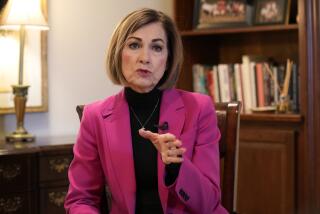Payday scammers or saviors?
In the second installment of this week’s Dust-Up, Thornberg and Leonard debate regulation of payday lenders. Previously, they the public’s reluctance to support federal assistance to troubled borrowers. Later in the week, they’ll discuss the Bear Stearns deal and whether lenders should be required to renegotiate mortgages with borrowers who are in default.
Meeting a demand
By Christopher Thornberg
One of my favorite movies that came out in recent years is “Thank You for Smoking,” which followed the adventures of a public relations specialist for the tobacco lobby. In the movie, the protagonist held regular dinner meetings with lobbyists from the gun and alcohol industries; they called their group the “MOD” squad, which stood for “Merchants of Death.” I wonder why the screenwriters didn’t include the payday lending industry, given that it too suffers from the same issues of widespread derision despite the fact that it serves a large public demand.
I would be the first to admit that it is hard to justify the seemingly outrageous fees charged by many payday lenders for small, short-term loans; I’m not going to try to here. Instead, I’ll point out a few things that may make the picture seem a little less clear.
Despite high fees, people continue to use payday lenders with some frequency. Fool me once, shame on you; fool me eight or nine times, and clearly something else is up. It might be easy to accuse the firms of taking advantage of people and earning unfairly high profits, but if profits are so high, why hasn’t there been a mad rush by the very competitive banking industry to provide these services in underserved neighborhoods? Given my personal financial institution’s predilection for hidden fees and what would seem to be unfair charges for even simple services, I wouldn’t chalk it up to an ethics issue.
We also need to remember that before there were payday lenders, folks hard up for a few bucks had to go to an underground lender who would charge even more outrageous fees and possibly threaten bodily harm.
As an economist, when I see something so clearly “wrong” with the functioning of the market, I want to find out “why” before leaping to regulate. What is clear is that many neighborhoods are financially underserved for a variety of reasons.
Payday lenders have filled a need, albeit at a high price. Any government body intervening in the situation would be well advised to think beyond the knee-jerk reaction of price-fixing as a solution, because this would only cause the demand to go unmet yet again. Worse, it would push people back to the black market for short-term capital needs.
Not too long ago, economist Muhammad Yunus found the same unmet financial needs in the slums of Bangladesh. He formed a micro-finance firm to meet these needs in an affordable way. His efforts have helped thousands -- if not millions -- of people help themselves and earned him a Nobel Peace Prize. iRather than take the easy and ultimately doomed-to-fail way that politicians are embracing, perhaps the best method to deal with payday lenders is to beat them at their own game and stimulate a similar revolution in micro-lending in underserved areas.
Christopher Thornberg is a founding partner with Beacon Economics.
Payday loans prey on the vulnerable
By Paul Leonard
March 26, 2008
While payday loans are marketed as short-term loans to address financial shortfalls between paychecks, they typically end up trapping borrowers in a cycle of long-term debt. Because payday loans are typically offered at annual percentage rates of 400%, with the entire loan amount plus accrued interest due in two short weeks, borrowers who pay back their loan are often unable meet their other obligations without taking out a new payday loan during the same pay period. This is the start of the debt trap, which can leave borrowers indebted to payday lenders for several months or years. This repeat borrowing is crucial to the payday lending business model, despite their professed desire to only meet short-term credit needs.
Chris, let me address the issues you raise. First, you rightly note that the typical borrower takes out multiple loans, with the national average among states that offer such loans at around nine a year. The typical borrower will pay more than $800 to repay a $325 loan. That’s not because consumer has a series of financial emergencies. Rather, the loans are designed to require repeat borrowing -- they are issued without any evaluation of the borrower’s ability to repay the loan, and most borrowers on limited incomes can’t afford to make the balloon payment on their loan in two weeks. But they can afford another $45 to renew or take out another one right away. In fact, the lenders prefer it that way. Payday loans are the Lay’s potato chips of consumer credit -- only 2% to 4% of the millions of loans issued go to borrowers who take out just one.
Why aren’t banks rushing to compete in this space? A good question, to which I think FDIC Chairwoman Sheila Bair has the key answer. Banks are making huge profits off their “courtesy overdraft” fees on their customers to the tune of $17.5 billion annually. Why cannibalize their profits with more responsible small loan products?
I would also ask why you think payday lenders don’t compete with each other. We have 2,500 payday lenders in California, more than the number of McDonald’s and Burger King outlets combined, yet virtually every one charges the maximum amount allowed by state law. We know they can be profitable with lower fees, because some states limit charges to $10 per $100, some $15, some $20.
You suggest that borrowers are worse off without access to these excessively costly payday loans. I beg to differ. First, 12 states and the District of Columbia (accounting for about 25% of the U.S. population) cap interest rates for all small loans at or around 36% APR. We don’t hear many horror stories about folks who can’t get access to credit from those states. Nor do we hear about how borrowers without checking accounts -- a prerequisite for a payday loan -- are suffering with the corner loan sharks.
You suggest the Grameen Bank may be a good model for the development of an alternative channel for short-term, small-dollar loans. There are some important differences here, in that the Grameen Bank is dedicated to building wealth by investing in small businesses. The payday lending industry is just the opposite, as it targets economically vulnerable borrowers with a product that usually does more harm than good.
Some interesting alternatives to payday lending are arising from another part of the financial services sector: credit unions. A number of large credit unions are beginning to offer affordable cash advances to their members as a service, some with savings components to help borrowers save for future financial emergencies. The North Carolina State Employees Credit Union offers an alternative payday loan product, at 12% APR with no additional fees, that has given out $1 billion in small loans to nearly 100,000 members since its inception. The three largest credit unions in California all have affordable short-term loan products as well.
Ultimately, what works is a reasonable interest rate cap. Congress determined that a 36% APR was high enough for the provision of credit to our military members and their families. It should be high enough for everyone else.
Paul Leonard is the director of the California office of the Center for Responsible Lending.
| Day 2 | |
More to Read
A cure for the common opinion
Get thought-provoking perspectives with our weekly newsletter.
You may occasionally receive promotional content from the Los Angeles Times.






